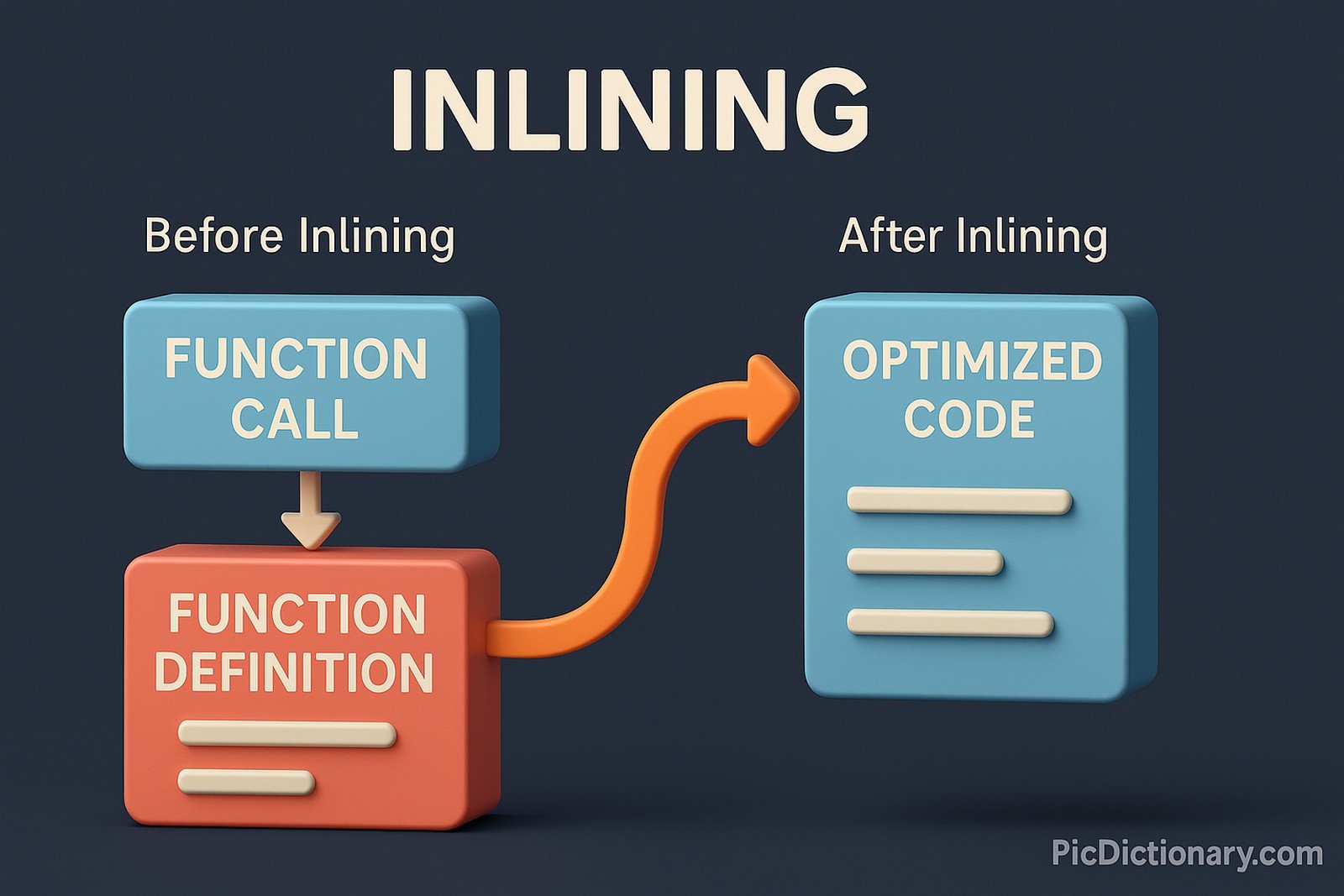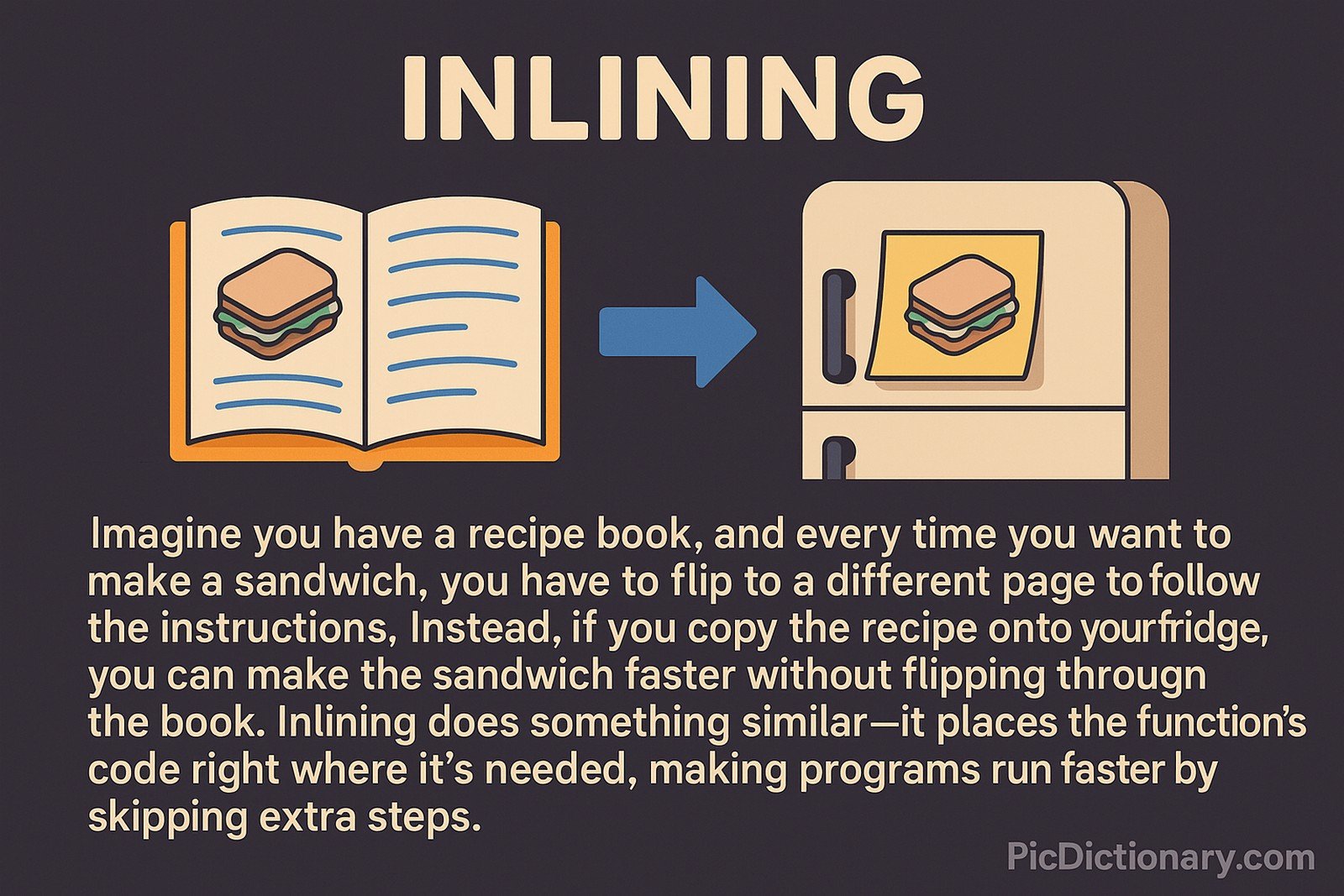Inlining

Quick Navigation:
- Inlining Definition
- Inlining Explained Easy
- Inlining Origin
- Inlining Etymology
- Inlining Usage Trends
- Inlining Usage
- Inlining Examples in Context
- Inlining FAQ
- Inlining Related Words
Inlining Definition
Inlining is a compiler optimization technique where function calls are replaced with the actual function code to reduce function call overhead and improve execution speed. Instead of jumping to a separate function, the compiler inserts the function’s body directly at the call site. This reduces function call overhead but may increase the code size, leading to potential cache inefficiencies. Inlining is widely used in performance-critical applications such as embedded systems, gaming engines, and high-frequency trading platforms.
Inlining Explained Easy
Imagine you have a recipe book, and every time you want to make a sandwich, you have to flip to a different page to follow the instructions. Instead, if you copy the recipe onto your fridge, you can make the sandwich faster without flipping through the book. Inlining does something similar—it places the function’s code right where it’s needed, making programs run faster by skipping extra steps.
Inlining Origin
Inlining has been a part of compiler optimizations since the early days of programming languages like C. It became more prominent with Just-In-Time (JIT) compilation techniques and modern compiler designs that focus on execution speed.
Inlining Etymology
The term "inlining" comes from the idea of "inserting in-line," meaning the function's code is placed directly in the flow of execution instead of being called separately.
Inlining Usage Trends
Inlining has grown in importance with modern compiler optimizations. While early languages relied heavily on function calls to modularize code, contemporary performance-driven applications use aggressive inlining techniques to optimize execution. However, compilers must balance inlining to avoid excessive code bloat, which can degrade cache performance.
Inlining Usage
- Formal/Technical Tagging:
- Compiler Optimization
- Code Performance
- Function Call Optimization - Typical Collocations:
- "inline function"
- "compiler inlining"
- "manual vs. automatic inlining"
- "performance impact of inlining"
Inlining Examples in Context
- The C++
inlinekeyword suggests that a function should be inlined for performance gains. - Just-In-Time (JIT) compilers decide in real-time whether inlining will benefit execution speed.
- Inlining is often used in embedded systems to reduce the overhead of function calls.
Inlining FAQ
- What is inlining in programming?
Inlining is a compiler optimization where function calls are replaced with the actual function body to improve performance. - Why is inlining used?
It reduces function call overhead and can improve execution speed by eliminating unnecessary jumps in the code. - Does inlining always improve performance?
No, excessive inlining can lead to code bloat, which might negatively impact CPU cache efficiency. - How do compilers decide when to inline?
Modern compilers use heuristics, such as function size and call frequency, to determine whether inlining would be beneficial. - What languages support inlining?
Many languages, including C, C++, Java (via JIT), and Rust, support some form of inlining optimization. - Is manual inlining better than compiler inlining?
Not necessarily—compilers can make better inlining decisions based on optimization metrics. - Can inlining increase code size?
Yes, excessive inlining can cause "code bloat," where the binary size grows significantly. - What is the difference between inlining and function calls?
Function calls require jumping to a separate memory location, while inlining places the function code directly at the call site. - Does inlining work with recursion?
Generally, no—recursive functions are not inlined since they depend on multiple call instances. - How does inlining affect debugging?
Inlined functions can make debugging harder because function calls disappear, making it difficult to trace execution flow.




Inlining Related Words
- Categories/Topics:
- Compiler Design
- Code Optimization
- Software Performance
Did you know?
Inlining was originally a manual technique used by assembly programmers before modern compilers automated the process. Early optimizers in the 1970s and 1980s focused on reducing function call overhead by substituting function bodies directly into the code, laying the foundation for modern compiler strategies.
PicDictionary.com is an online dictionary in pictures. If you have questions or suggestions, please reach out to us on WhatsApp or Twitter.Authors | Arjun Vishnu | @ArjunAndVishnu

I am Vishnu. I like AI, Linux, Single Board Computers, and Cloud Computing. I create the web & video content, and I also write for popular websites.
My younger brother, Arjun handles image & video editing. Together, we run a YouTube Channel that's focused on reviewing gadgets and explaining technology.



Comments powered by CComment